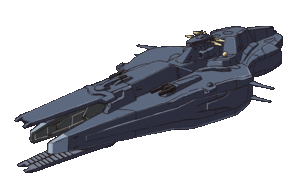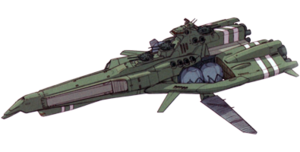Difference between revisions of "Neo-Jovian Ship Recognition Guide"
m (Created page with "==Space Independence Alliance/Neo-Jove== '''Supercarrier ''Defiance''''' [http://mahq.net/mecha/gundam/msgundam/dolos.jpg Image]<br> :Anti-Ship Armament: S :Anti-Air Armament: ...") |
m |
||
| Line 30: | Line 30: | ||
Several of these ships managed to escape internment and scrapping at the end of the war and despite their age form the nucleus of the Neo-Jovian Mobile Fleet. All have been refitted with modern electronics and defenses at [REDACTED] and draw a disproportionate number of skilled, veteran pilots. | Several of these ships managed to escape internment and scrapping at the end of the war and despite their age form the nucleus of the Neo-Jovian Mobile Fleet. All have been refitted with modern electronics and defenses at [REDACTED] and draw a disproportionate number of skilled, veteran pilots. | ||
| + | |||
| + | [[file:LAclass.png|thumb|Post-war upgraded ''Los Angeles'' class with augmented reaction mass tanking spheres.]] | ||
| + | '''''Los Angeles''-class Cruiser''' | ||
| + | :'''Armament''' | ||
| + | ::*3 Beam Turrets | ||
| + | ::*6 Turreted Autorails | ||
| + | ::*4 Cluster Missile Pods | ||
| + | ::*1 Laser PD Array | ||
| + | :'''Small Craft''' | ||
| + | ::*8 Mobile Suits | ||
| + | ::*1 medium-sized shuttle | ||
| + | :'''Special''' | ||
| + | ::*Continuous-Wormhole Drive | ||
| + | Widely viewed as the best cruiser of the System War, the ''Los Angeles'' class remains a viable cruiser to this day. Its replacement remains controversial, and upgraded models continue to be built for states throughout known space. It is well-armed and reasonably armored, but it has a less-efficient power system that hampers its endurance and maximum speed. | ||
| + | |||
| + | Much of the longitevity of the class can be attributed to the fact that the ''Los Angeles'' design struck an excellent balance between systems; the resulting ship was an excellent jack of all trades. While this comes with the unfortunate corolary of 'master of none', the ''LAs'' also pioneered a number of naval architectural innovations and were robust, 'happy' ships in service. Built in limited numbers before the war, production was increased massively during wartime and it was extremely common for these ships to be fighting on both sides in the same battle. Originally fitted with railguns in their primary turrets, production soon switched to beam cannons. Their large onboard hangars (for a cruiser of the era) made them popular with admirals on both sides and their tactical flexibility kept them in heavy demand. | ||
| + | |||
| + | Neo-Jove operates a number of ''Los Angeles'' class ships, all modified from their base specifications. The biggest upgrades have been to the power systems; all have gone through a comprehensive refit to replace the war-era fusion powerplants with more efficient modern models. This has improved their endurance, which is further augmented by extra reaction mass tanking. | ||
Revision as of 00:53, 28 July 2011
Space Independence Alliance/Neo-Jove
Supercarrier Defiance Image
- Anti-Ship Armament: S
- Anti-Air Armament: B
- Defenses: A
- Mobility: D
- Craft Complement: S+
- Electronics: C
Only three of these monster warships were completed by the Space Independence Alliance during the war; two (including the original Enteebee ) were destroyed near the end of the war and the third, the Defiance, jumped out of Sol to an unknown destination. There are intermittent reports of its movement, though no INTACT task force has been able to track this ship down.
If sighted, do not engage. Retreat, report immediately and await further orders.
Liberator-class Battleship Image
- Anti-Ship Armament: A
- Anti-Air Armament: B
- Defenses: S
- Mobility: C
- Craft Complement: D
- Electronics: D
The last design of rebel battleship was fortunately built in small numbers, but most those not destroyed fled to unoccupied space. These vessels quite simple outclass anything less than a modern League or SFN battleship, and are legendary for taking a pounding and shredding cruisers easily. While the Liberator is less of a threat to mobile suits than to capital ships, it should not be underestimated. A linear flak cannon is no less deadly for its age, and these ship have plenty of them.
Adams-class Battleship
- Anti-Ship Armament: B
- Anti-Air Armament: B
- Defenses: B
- Mobility: D
- Craft Complement: A
- Electronics: C
Originally built as a counterpart and competitor to the Kilimanjaro class, the Fuji class emphasised mobile weapon handling spaces over range and gunnery firepower. The primary contractors were in Jovian space and when the Jovian Republic declared its independence the yards and several partially-completed hulls were seized and rapidly put into service. Renamed the Adams class they were, for a time, the most advanced and powerful ships in Jovian service and until the late-war introduction of the Defiance class, the ships with the largest mobile suit complement.
Several of these ships managed to escape internment and scrapping at the end of the war and despite their age form the nucleus of the Neo-Jovian Mobile Fleet. All have been refitted with modern electronics and defenses at [REDACTED] and draw a disproportionate number of skilled, veteran pilots.
Los Angeles-class Cruiser
- Armament
- 3 Beam Turrets
- 6 Turreted Autorails
- 4 Cluster Missile Pods
- 1 Laser PD Array
- Small Craft
- 8 Mobile Suits
- 1 medium-sized shuttle
- Special
- Continuous-Wormhole Drive
Widely viewed as the best cruiser of the System War, the Los Angeles class remains a viable cruiser to this day. Its replacement remains controversial, and upgraded models continue to be built for states throughout known space. It is well-armed and reasonably armored, but it has a less-efficient power system that hampers its endurance and maximum speed.
Much of the longitevity of the class can be attributed to the fact that the Los Angeles design struck an excellent balance between systems; the resulting ship was an excellent jack of all trades. While this comes with the unfortunate corolary of 'master of none', the LAs also pioneered a number of naval architectural innovations and were robust, 'happy' ships in service. Built in limited numbers before the war, production was increased massively during wartime and it was extremely common for these ships to be fighting on both sides in the same battle. Originally fitted with railguns in their primary turrets, production soon switched to beam cannons. Their large onboard hangars (for a cruiser of the era) made them popular with admirals on both sides and their tactical flexibility kept them in heavy demand.
Neo-Jove operates a number of Los Angeles class ships, all modified from their base specifications. The biggest upgrades have been to the power systems; all have gone through a comprehensive refit to replace the war-era fusion powerplants with more efficient modern models. This has improved their endurance, which is further augmented by extra reaction mass tanking.

